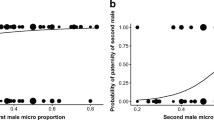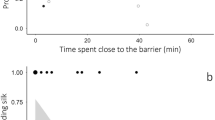Summary
For species exhibiting courtship feeding it is typically argued that the food gift presented by males is a sexually-selected trait in serving to acquire fertilizations. An alternative hypothesis is that the trait is maintained by natural selection for parental investment in which the fitness of the mating male's offspring is increased. Here I argue that the spermatophylax, a nutritious part of the spermatophore provided to female katydids, Requena verticalis, functions mainly as parental investment. Previous research suggested that variation in the size of the male donation in this species (1) did not influence the ability of males to transfer ejaculates and (2) resulted in variation in offspring fitness. In the present paper genetic markers and radiolabels are used to show that the offspring are fathered by the males that donate the nutrients. Although these results indicate that the large spermatophylax is maintained by selection for increased parental investment, it is likely that this male offering originated in a sexual selection context whereby males fed females in order to obtain fertilizations.
Similar content being viewed by others
References
Alexander RD, Borgia G (1979) On the origin and basis of the male-female phenomenon. In: Blum M, Blum N (eds) Sexual selection and reproductive competition in the insects. Academic Press, New York, pp 417–440
Backus V, Cade W (1986) Sperm competition in the field cricket, Gryllus integer (Orthoptera: Gryllidae). Fla Entomol 69:722–728
Boldyrev BT (1915) Contributions à l'étude de la structure des spermatophores et des particularités de la copulation chez Locustodea et Gryllodea. Horae Societatis Entomologicae Rossicae 6:1–245
Bowen BJ, Codd CG, Gwynne DT (1984) The katydid spermatophore (Orthoptera: Tettigoniidae): male investment and its fate in the mated female. Aust J Zool 32:23–31
Gwynne DT (1982) Mate selection by female katydids (Orthoptera: Tettigoniidae, Conocephalus nigropleurum). Anim Behav 30:734–738
Gwynne DT (1984a) Male mating effort, confidence of paternity and insect sperm competition. In: Smith RL (ed) Sperm competition and the evolution of animal mating systems. Academic Press, New York, pp 117–149
Gwynne DT (1984b) Courtship feeding increases female reproductive success in busherickets. Nature 307:361–363
Gwynne DT (1984c) Sexual selection and sexual differences in Mormon crickets (Orthoptera: Tettigoniidae, Anabrus simplex). Evolution 38:1011–1022
Gwynne DT (1985) Role-reversal in katydids: habitat influences reproductive behaviour (Orthoptera: Tettigoniidae: Metaballus sp.). Behav Ecol Sociobiol 16:355–361
Gwynne DT (1986a) Courtship feeding in katydids (Orthoptera: Tettigoniidae): investment in offspring or in obtaining fertilizations? Am Nat 128:342–352
Gwynne DT (1986b) Reply to: stepfathers in insects and their pseudo-parental investment. Ethology 71:74–77
Gwynne DT (1988) Courtship feeding and the fitness of female katydids. Evolution 42:545–555
Gwynne DT, Bowen BJ, Codd CG (1984) The function of the katydid spermatophore and its role in fecundity and insemination. Aust J Zool 32:15–22
Knowlton N, Greenwell S (1984) Male sperm competition avoidance mechanisms: the influence of female interests. In: Smith RL (ed) Sperm competition and the evolution of animal mating systems. Academic Press, New York, pp 61–84
Lack D (1940) Courtship feeding in birds. Auk 57:169–178
Lloyd JE (1979) Mating behavior and natural selection. Fla Entomol 62:17–34
Lyon BE, Montgomerie RD (1985) Incubation feeding in snow buntings: female manipulation or male parental care? Behav Ecol Sociobiol 17:279–284
Nichols EA, Ruddle FH (1973) A review of enzyme polymorphism, linkage and electrophoresis conditions for mouse and somatic cell hybrids in starch gels. J Histochem Cytochem 21:1066–1081
Parker GA (1970) Sperm competition and its evolutionary consequences in the insects. Biol Rev 45:525–567
Parker GA, Smith JL (1975) Sperm competition and the evolution of the precopulatory passive phase in Locusta migratoria migratoria. J Entomol [A] 49:155–171
Quinn JS, Sakaluk SK (1986) Prezygotic male reproductive effort in insects: why do males provide more than sperm? Fla Entomol 69:84–94
Ridley M (1978) Paternal care. Anim Behav 26:904–932
Rentz DC (1972) The lock and key as an isolating mechanism in katydids. Am Sci 60:750–755
Sakaluk SK (1984) Male crickets feed females to ensure complete sperm transfer. Science 223:609–610
Sakaluk SK (1986a) Is courtship feeding by male insects parental investment? Ethology 73:161–166
Sakaluk SK (1986b) Sperm competition and the evolution of nuptial feeding behavior in the cricket, Gryllodes supplicans (Walker). Evolution 40:584–593
Simmons LW (1987) Sperm competition as a mechanism of female choice in the field cricket Gryllus bimaculatus. Behav Ecol Sociobiol 21:197–202
Simmons LW (1988) The contribution of multiple mating and spermatophore consumption to the lifetime reproductive success of female field crickets (Gryllus bimaculatus De Geer). Ecol Entomol 13:57–69
Thornhill R (1976a) Sexual selection and paternal investment in insects. Am Nat 110:153–163
Thornhill R (1976b) Sexual selection and nuptial feeding behavior in Bittacus apicalis (Insecta: Mecoptera). Am Nat 110:529–548
Trivers RL (1972) Parental investment and sexual selection. In: Campbell B (ed) Sexual selection and the descent of man, 1871–1971. Aldine, Chicago, pp 136–179
Wickler W (1985) Stepfathers in insects and their pseudo-parental investment. Z Tierpsychol 69:72–78
Zeh DW, Smith RL (1985) Paternal investment by terrestrial arthropods. Am Zool 25:785–805
Author information
Authors and Affiliations
Rights and permissions
About this article
Cite this article
Gwynne, D.T. Courtship feeding in katydids benefits the mating male's offspring. Behav Ecol Sociobiol 23, 373–377 (1988). https://doi.org/10.1007/BF00303711
Received:
Accepted:
Issue Date:
DOI: https://doi.org/10.1007/BF00303711




